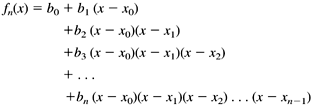6.1 The Power Form versus the Newton Form
6.1 The Power Form versus the Newton Form We are familiar with the power form of a polynomial of degree n: We'll use the subscript n after the name of the function to indicate the function's degree, its highest exponent of x. Another polynomial form is the Newton form: which is computationally convenient because of the way the ( x - x i ) products accumulate from one term to the next?awe simply multiply the previous product by the next ( x - x i ). The x i constants are called centers. We'll use the Newton form to represent polynomial interpolation functions. [1]
|
| |
| Top |
EAN: 2147483647
Pages: 141

